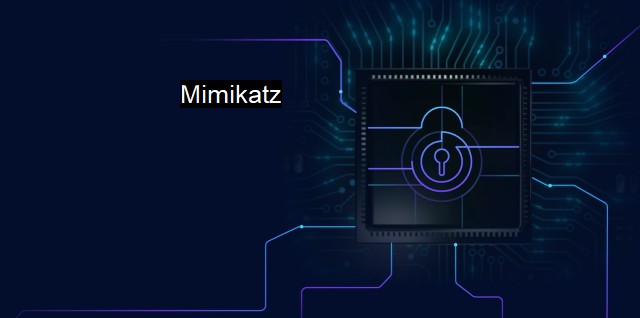What is Mimikatz?
Exploring the Dangers of Mimikatz: Its Ability to Extract Sensitive Data is a Serious Threat to Cybersecurity. Here's How It Works and How to Protect Against It.
Mimikatz is a well-known cybersecurity tool, notorious among system administrators and malicious hackers alike. Born out of necessity, the tool was originally conceived and created by Benjamin Delpy, a French information security expert. It is often regarded as a powerful weapon among an arsenal along with other penetration testing frameworks and custom-developed spyware.The primary function of Mimikatz is to extract plaintext passwords, handle credentials, and brute force logons right from the memory of the Windows operating system. It has the capacity to exploit numerous Windows vulnerabilities--a feature that makes it very attractive for criminal hackers. Conversely, it is essential to cybersecurity personnel because it gives them the means to penetrate networks deeply and thereby discover and rectify vulnerable areas.
Mimikatz operates by exploiting a feature built into Windows called 'Wdigest,' designed to allow single sign-on across applications without needing to repeatedly type passwords. Wdigest stored passwords in memory as plaintext data, allowing Mimikatz to technically circumvent system integrity and access password information. Though Microsoft altered this feature in 2014 for Windows to zero out plaintext passwords, Mimikatz has adapted and continues to be quite potent in its capabilities in penetrating current systems.
When utilized by cybersecurity teams, the utility of Mimikatz is clear for penetration testing and identification of vulnerabilities oft abused by malicious actors. it is also frequently used by threat actors aiming to gain unauthorized access to systems and networks. It has been deployed in sophisticated cyber attacks across the globe, including several notable hacking incidents such as NotPetya and the Dukes APT.
One of the common issues regarding Mimikatz detection and subsequent countermeasures is the classic antivirus evasion methods which it employs. Traditional antivirus programs rely primarily on signature-based detection methods. Mimikatz often undergoes regular updates and revisions, effectively altering its signature and make it virtually undetectable via such measures. This hacking tool has adapted over time to persistently remain a threat.
Thus, implementing active cybersecurity measures to counter Mimikatz necessitates adopting a layered approach. This approach implies operating at the machine level with advanced protections such as Credential Guard for Windows-based devices, investing in next-generation antiviruses that are capable of detecting and blocking actions associated with Mimikatz's exploits, and other threats based on their behavior and not their signatures. It also includes educating and training staff about cybersecurity hygiene as well as employing undercover penetration testing, firewall, traffic monitoring, intrusion detection, and prevention systems.
Unscrupulous users have often employed Mimikatz for illegal undertakings; the tool can and has been used constructively by ethical hackers and information security teams. It provides the means and opportunity for these professionals to understand possible weak points in systems and closes the vulnerabilities potentially exploitable by attackers.
Mimikatz stands unique in the realm of cybersecurity and antiviruses, being a tool with dual-edged utility. It serves as a testament to the theory that the boundaries between ethical hacking and cybercrime lies not within the tools employed, but rather the motives and actions of the person wielding them. Consequently, it underlines the need for constant vigilance, updated security measures, and cybersecurity education in the face of evolving and persistently present threats to information systems and infrastructural security.

Mimikatz FAQs
What is Mimikatz?
Mimikatz is a tool that allows an attacker to extract credentials, such as passwords, from Windows machines. It was originally designed to test the security of Windows systems, but it is now commonly used by hackers to steal login credentials.How does Mimikatz work?
Mimikatz works by exploiting weaknesses in the way Windows stores user credentials. It uses a variety of techniques, such as dumping memory, intercepting network traffic, and performing pass-the-hash attacks, to extract login credentials from a target system.How can I detect Mimikatz on my system?
There are several ways to detect Mimikatz on your system. Some antivirus programs are able to detect and block Mimikatz, but it can often evade detection by using techniques such as code obfuscation. Another way to detect Mimikatz is to look for suspicious network traffic or unusual activity on your system, such as new user accounts or unauthorized logins.How can I protect myself from Mimikatz?
To protect yourself from Mimikatz, you should follow good cybersecurity practices, such as using strong passwords, keeping your software up to date, and avoiding suspicious links or downloads. You should also use antivirus software that is able to detect and block Mimikatz. Additionally, you can use techniques such as multi-factor authentication and privilege escalation controls to limit the impact of any successful Mimikatz attacks.Related Topics
Credential Theft Windows Security Privilege Escalation Password Cracking Malware Analysis
| | A | | | B | | | C | | | D | | | E | | | F | | | G | | | H | | | I | | | J | | | K | | | L | | | M | |
| | N | | | O | | | P | | | Q | | | R | | | S | | | T | | | U | | | V | | | W | | | X | | | Y | | | Z | |
| | 1 | | | 2 | | | 3 | | | 4 | | | 7 | | | 8 | | |||||||